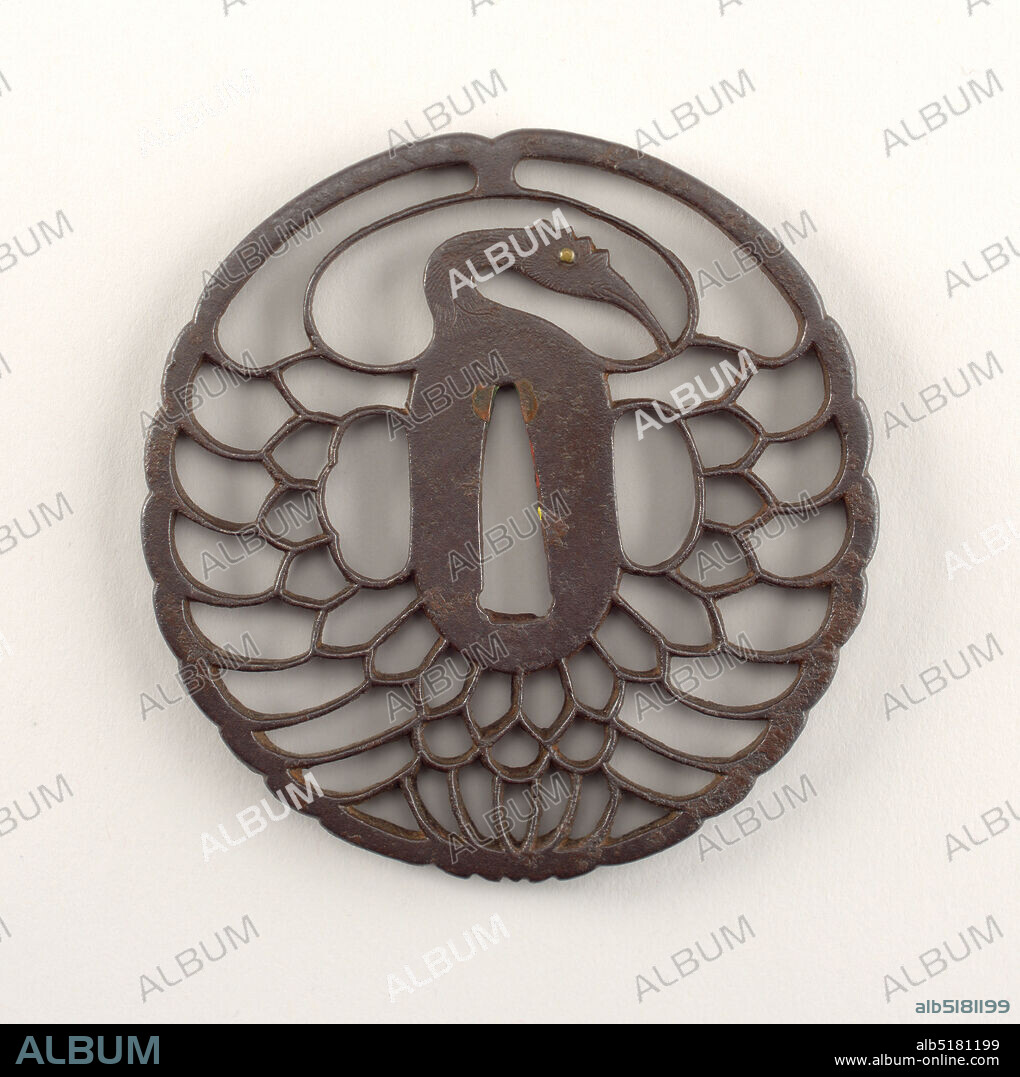alb5181199
Chrysanthemum crane, Iron, shakudo (a soft copper and gold alloy), This Kyo-sukashi (Kyoto openwork) style tsuba takes the form of a tsuru maru (crane circle). At the center is the nakago-ana, an opening through which the sword passes, with traces of sekigane (plugs added to fit the tsuba to a sword) made of shakudo (a soft copper and gold alloy). The surrounding seppadai (flat oval area) forms the body of the crane; it is elegantly long and narrow, with a migaki (burnished) surface. The head of the crane has kebori (line carving). Flanking the body are ryo-hitsu, openings for the kozuka (utility knife) and the kogai (skewer tool). At right is sashi ura, the side which faces the blade, whose opening takes the hangetsu-kei (half moon) shape. Opposite is sashi omote, the side which faces the sword hilt; its tri-lobed opening is of the suhama type, and symbolically represents the coastline of Horai, the holy island of the Immortals. The surrounding openwork forms symmetrical feathers with a sense of movement., Japan, 17th century, knotted, knitted and crocheted textiles, Decorative Arts, Tsuba, Tsuba.

|
Zu einem anderen Lightbox hinzufügen |
|
Zu einem anderen Lightbox hinzufügen |



Haben Sie bereits ein Konto? Anmelden
Sie haben kein Konto? Registrieren
Dieses Bild kaufen

Untertitel:
Siehe automatische Übersetzung
Chrysanthemum crane, Iron, shakudo (a soft copper and gold alloy), This Kyo-sukashi (Kyoto openwork) style tsuba takes the form of a tsuru maru (crane circle). At the center is the nakago-ana, an opening through which the sword passes, with traces of sekigane (plugs added to fit the tsuba to a sword) made of shakudo (a soft copper and gold alloy). The surrounding seppadai (flat oval area) forms the body of the crane; it is elegantly long and narrow, with a migaki (burnished) surface. The head of the crane has kebori (line carving). Flanking the body are ryo-hitsu, openings for the kozuka (utility knife) and the kogai (skewer tool). At right is sashi ura, the side which faces the blade, whose opening takes the hangetsu-kei (half moon) shape. Opposite is sashi omote, the side which faces the sword hilt; its tri-lobed opening is of the suhama type, and symbolically represents the coastline of Horai, the holy island of the Immortals. The surrounding openwork forms symmetrical feathers with a sense of movement., Japan, 17th century, knotted, knitted and crocheted textiles, Decorative Arts, Tsuba, Tsuba
Bildnachweis:
Album / quintlox
Freigaben (Releases):
Model: Nein - Eigentum: Nein
Rechtefragen?
Rechtefragen?
Bildgröße:
5195 x 5216 px | 77.5 MB
Druckgröße:
44.0 x 44.2 cm | 17.3 x 17.4 in (300 dpi)
 Pinterest
Pinterest Twitter
Twitter Facebook
Facebook Link kopieren
Link kopieren Email
Email
